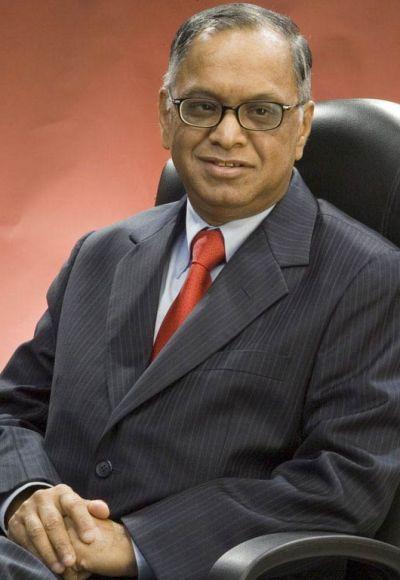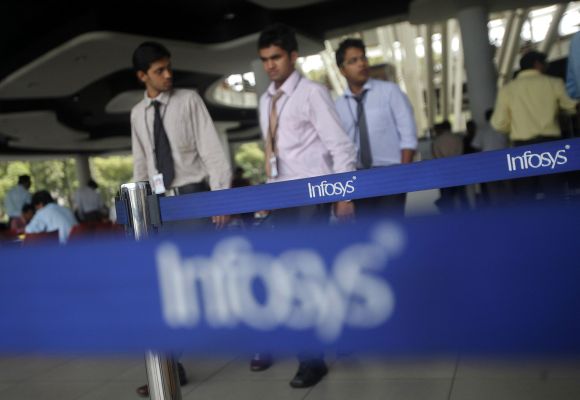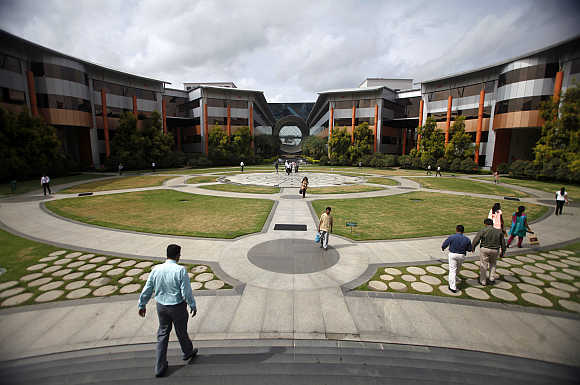Photographs: Courtesy, Infosys T V Mohandas Pai
The company needs to revamp sales, focus on acquisition and empower employees.
Narayana Murthy has been invited back to Infosys. The board, in its wisdom, called him back to get the company going again.
Everything that could have gone wrong has gone wrong. Sales are down, profits are down, employee morale is low, the strategy is confused, and the famed PSPD model - predictability of revenues, sustainability of revenues, profitability of revenues and de-risking of business - is a matter of the past.
The company looks divided and the decline has been sudden - in six to eight quarters after a glorious 17 years.
It is not that there is gloom and doom in the market; three other competitors have done well.
The crisis is clearly one of leadership, shocking the board adequately to call the 68-year-old founder back from retirement to complete the unfinished agenda.
...
Mohandas Pai: How Murthy can turn around Infosys
Image: Infosys headquarters, Bangalore.Photographs: Courtesy, Infosys
It is also a crisis of governance because the board clearly failed to make a succession plan work after the long reign of the Founder Group.
The biggest challenge is to improve employee morale. A group of highly qualified, highly trained employees needs to be motivated to get back on the high performance culture for which the company was well known.
The most critical need is to reinvigorate the sales engine and get revenues flowing again. The guidance for the year of six to 10 per cent is anaemic and below potential.
Many good sales staff seem to have left in the past two years, and the remaining ones seem stuck in a cycle of slow decision-making and contract-closure.
Quick decision-making and closing deals is important as also incentivising the sales staff on performance and closely working with them.
...
Mohandas Pai: How Murthy can turn around Infosys
Image: An employees walks past a signage board in the Infosys campus at the Electronics City IT district in Bangalore.Photographs: Vivek Prakash/Reuters
Client-centricity and service should be rebuilt and contacts re-established with top leaders in client organisation.
The single-minded aggressive pursuit of sales and revenue will turn the tide as increased sales will keep everybody busy, reduce the bench and increase compensation to all, as also profits.
Along with this, the sales staff and unit leadership need to be fully empowered to take decisions, and the bad practice of letting the back office stymie sales decisions needs to be reversed.
Murthy had always said for any company, sales was the most difficult task and the sales team was the most important part of business.
Senior managers need to travel more to meet clients and the silly step of cutting travel budgets has hurt the company immensely.
...
Mohandas Pai: How Murthy can turn around Infosys
Image: Employees walk in front of a building dubbed the ''washing machine'', a well-known landmark built by Infosys.Photographs: Vivek Prakash/Reuters
It is important, too, to incentivise and reward the top sales performers and stop the socialistic method of not differentiating top performers.
The current strategy of consulting-led, enterprise-based selling is the natural outcome for the company after many years of delivery excellence. But the execution of the strategy was flawed.
The strategy requires a more client-centric, more market-facing, empowered and federated organisation structure where country practices take decisions and lead the delivery efforts.
The centralised model, where a few took convoluted decisions that were over analysed, almost to death, needs to be put to bed.
It also means that executive power will move to the staff in the front and the head office will play a supporting role.
...
Mohandas Pai: How Murthy can turn around Infosys
Image: Employees of Indian software company Infosys walk past Infosys logos at their campus.Photographs: Vivek Prakash/Reuters
The failure was the highest here because the strategy changed, but not the empowerment. Along with this, the compensation structure needs to change to reflect performance.
Organic growth at a time of slow market growth is difficult and acquisition becomes core to the strategy.
For too long the company has created difficulties for itself by self-imposed conditions for acquisitions by which globally there were extremely few companies that met the bill.
The business process outsourcing subsidiary has clearly demonstrated how to make small acquisitions work. Of course, large acquisitions are not the answer as integration efforts can be killing.
But a series of small, quick acquisitions that offer new markets, new verticals or lines of business are certainly needed. A competitor has effectively used this strategy to overtake Infosys in the recent past.
...
Mohandas Pai: How Murthy can turn around Infosys
Image: Infosys' earlier board of directors.Photographs: Courtesy, Infosys
Along with this, the next generation of leaders needs to be given the reigns, empowered fully, given aspirational targets and incentivised to perform.
The company has at least 100 leaders who could be CEOs of small, medium and large companies. Many of them have left and are CEOs elsewhere and performing well.
But they need to be given their day in the sun, and the culture of a founder-led and founder-centric governing model has to be abandoned, since it no longer works.
The company has lost three generations of leaders over the past 25 years because of this policy, which meant that they could never aspire to lead.
The basic problem of Infosys has been this leadership crisis, and this needs to be set right first.
...
Mohandas Pai: How Murthy can turn around Infosys
Image: Employees walk in a forecourt at the Infosys campus.Photographs: Vivek Prakash/Reuters
In addition, a new leadership team should be put in place to last the next seven to 10 years to take the company forward. This would need the board to be restructured to make it smaller and more nimble.
With a large number of internal members, the board is too large, needing an adequate number of independent directors to balance the internal ones.
Globally, it is being increasingly seen, the number of insiders are restricted on boards to make them smaller and more effective.
All this change needs a charismatic, inspirational leader and there can be no better one than Murthy.
In a way, with his return, the board has accepted its inability in providing the right direction and in putting a good leadership team in place. But it deserves our kudos for admitting its mistake and taking the right decision.
...
Mohandas Pai: How Murthy can turn around Infosys
Photographs: Vivek Prakash/Reuters
Infosys is not an ordinary company. It is the poster child of India's liberalisation; the dream company of India's educated middle class; the role model; the company that led and set standards in business performance, governance, employee policies, strategy, value creation for all stakeholders, enhancing investor protection and keeping the faith of overseas investors for so long.
It symbolised the new India, based on merit, openness, transparency and trust, qualities severely lacking in our public life today.
Of course, its own performance and standards set such a high bar that many just gave up trying to follow this model, and it became a victim of its own success. But the resurrection of the company gives new hope that the story will continue.
If Murthy can turn it around, make the new leadership perform and then go into the sunset within three years along with his son Rohan, his legacy would keep us proud for many years to come.
The author was CFO and HR head at Infosys. He is currently Chairman, Aarin Capital Partners










article